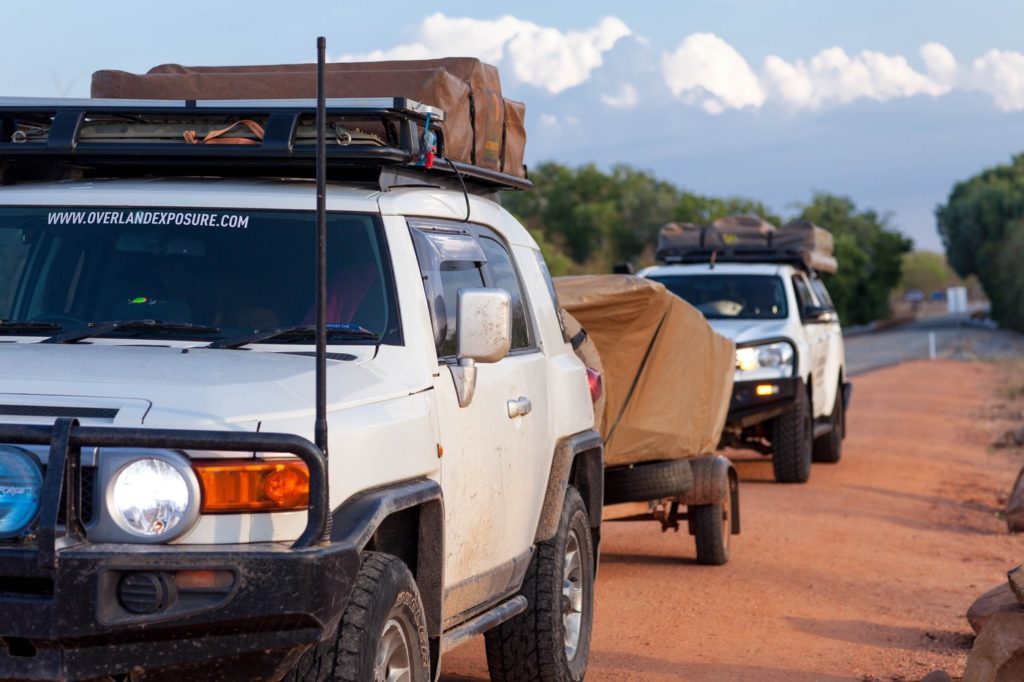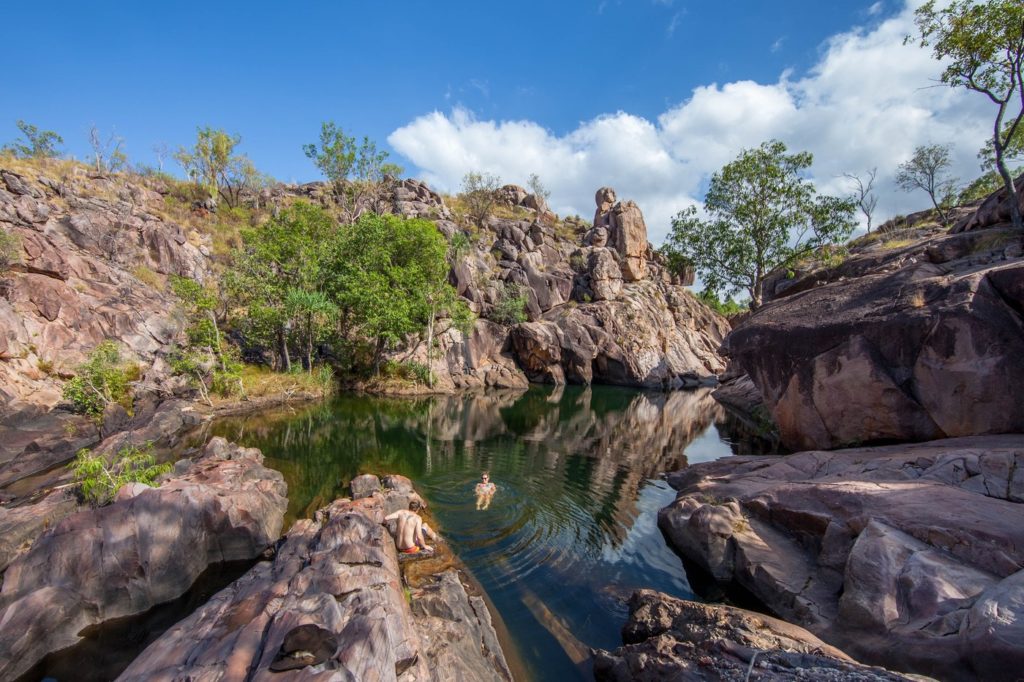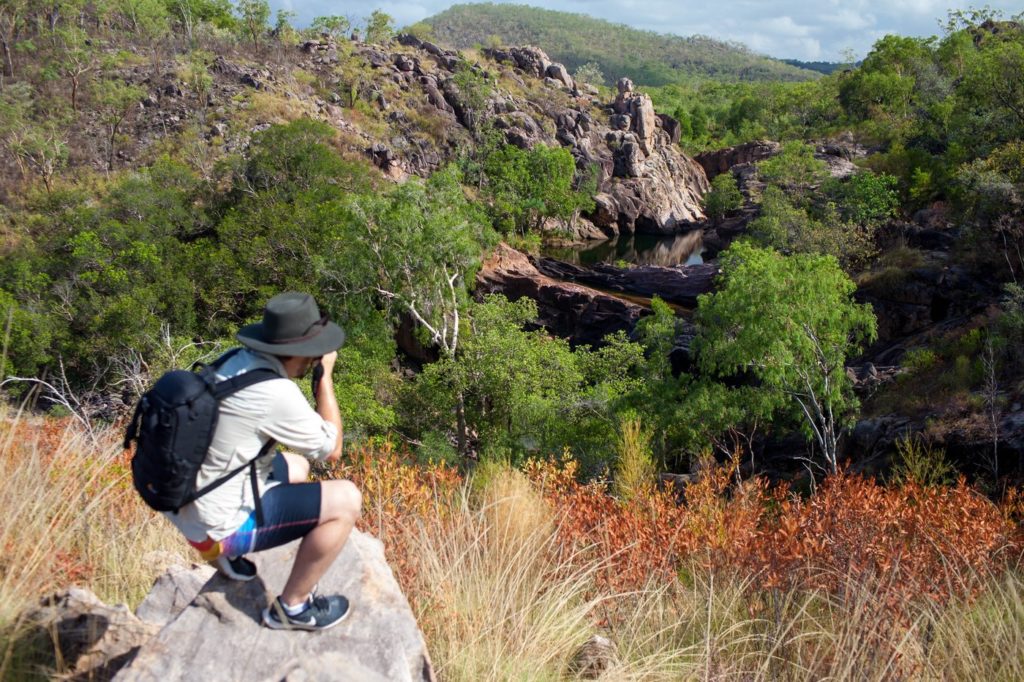‘We’ve booked flights for October’.
An ambitious time for southerners to visit the tropics. It is the start of the build-up to the wet season – a time of year still mild and pleasant down south, but here in the top end our cool evening breezes and gentle dry season weather are beginning to give way to oppressive humidity, searing sun and steadily rising temperatures of summer. They call it the build-up because that’s exactly what it does. It builds and builds until it breaks. It might break tomorrow, it might break in January, no one can be sure. It feels like a huge rain is about to drench us and cool everything off, but it just doesn’t arrive.
This just so happened to be the only time that our close friends Mat and Sash could fly up to Darwin from NSW, hire themselves an off-road camper and come exploring. With an ambitious week planned, we would be steering up the road into Kakadu World Heritage Area in search of adventure and excitement, accompanied by with plenty of relaxation and laughter around a bush campsite, with old mates.

With both Toyotas fuelled and packed, our rooftop-tent was mounted snugly on top and all our camping gear cleaned and packed neatly back where it should be. Water tanks were topped up and the tinny hitched up. Needing more cold storage space for an extra two appetites, we picked up a flash new YETI cooler I’d had my eye on for a while and iced down a week worth of drinks.
It wasn’t a fishing trip as such, but our mates were keen to get a taste of the territory lifestyle we’d been raving about each time we talked on the phone, so what better places to spot top end wildlife and enjoy the scenery than a mix of hiking trails and remote billabongs. It certainly wouldn’t hurt to throw some hard body ‘frog’ lures in the boat, ready to chase some Barramundi up through the freshwater.
Tracing out at a rough loop on a map, we’d start cutting across from Pine Creek, concentrating on the southern reaches of the national park. Kim and I having already spent some solid time in the northern end of Kakadu this season, were keen to cover some new ground with our mates. Steering past the edge of Litchfield NP, the run down to Pine Creek was a good stretch to calculate our fuel average with the boat in tow, making sure we would have enough range for our time in Kakadu.
We couldn’t pass up the chance to stop for a cold beer and a hearty burger down at the township of Adelaide River, before heading into the scrub for the week. One of the most northern defence lines in Australia during WW2, this little dot on the map is rich in history and the surrounding bushland rich in relics. Well worth exploring if you find yourself passing through. With a quick fuel top-up at Pine Creek, we calculated the diesel ‘hire-lux’ to be sipping 11L/100km compared to our V6 Petrol which was towing nicely but punishing my back pocket at 23.9L/100km.
The rocky hills and greenery soon gave way to flat, dry-country as we turned west off the Stuart Hwy, a flurry of excitement happening over the UHF radio as we commented on the scenery flying past the windows. A beautiful golden light bathed the ‘welcome to Kakadu’ sign as we arrived, only adding to our contentment at being back out in the wilderness, exploring together.
Our night stop for night one was to be Gunlom Falls. Along the corrugated red dirt track into the campsite, an LED lightbar lay in the middle of the track, a testament to the damage that these corrugated roads can do to ill-prepared vehicles. With little hope of finding its former owner in a huge park like this, we decided to rescue it. We unhitched the boat and propped ourselves up at camp just as the last light started to fade the red sunset. Before long the boys were hatching a plan to MacGyver up a bracket and fix the lightbar onto the nose of the boat for some night fishing. Meanwhile, the girls had a solid plan underway for us to all hike up the short trail to the bottom of the falls by torchlight and enjoy a moonlight swim.
Floating Under The Moonlight
As some of us flopped gracelessly into the water in darkness, others were understandably more tentative owing to the unfamiliar risk of crocodiles both fresh and the more dangerous saltwater variety, potentially inhabiting these waterways at certain times of the year. The rule of thumb is that the waters are thoroughly vetted for crocs before the Park Rangers open the park for the season, but it can still feel a little unnerving slipping into the black water under the cover of darkness. Once in, the water was a perfect temperature, the air above cooled off by the coming rain. Just what the doctor ordered after a day of driving in the dust and heat.

A memorable and ethereal experience it was, laying on our backs with ears dipped under the surface, we listened to the clicking and popping of bugs and fish underneath the water, as the rumble of thunder echoed down over the high cliffs above us. One of the first proper storms of the coming wet season, the long forks of lightning drew patterns across the night sky over our heads and the wind picked up pace. There was a sweet smell of coming rain on the breeze as this storm moved in. The atmosphere built steadily to a crescendo as the sky cracked open above us in huge flashes, dwarfing the huge Gunlom waterfall.
As soon as the first sprinkle of rain began, we ventured back to camp. After pausing briefly for brightly coloured native tree snake to cross the trail in front of us, we were immediately glad that we had taken Sash’s suggestion to pitch the 270’ awning on the FJ. The heavens suddenly opened up in a monsoonal downpour and we ran for cover. Huddling under our little ledge of dry cover as the campground around us filled with water, we were soon a little island amongst it. A damn fine choice to pitch camp on high ground.

Waking the next morning blue skies beamed above us as we broke camp, the parched land having soaked in the rain so quickly that you wouldn’t have known it rained at all the night before. We spent the morning hiking up through the steep scrub to the top of Gunlom falls, where there is a natural infinity pool looking across the picturesque valley. It would be easy to spend a day up there floating around in the pools, but there were many things still to see on the road ahead.
Rough Trails
The drive out of Gunlom campsite was an exercise in washing windscreens and keeping up momentum to limit wheel spin, the bright red soil having turned to rusty red mud which stuck to the vehicle like house paint as we scrambled our way out through the slippery roads. It’s worth motioning as a comparison – Mat and sash own a similarly setup FJ to ours back in Sydney and they had booked ahead to hire one up here but the hire company had given them a Hilux, as the FJ had been rolled over and totalled buy the last hirer. An ‘upgrade’ to a new Hilux they tried to sell it to him as, but poor Mat felt like he’d been handed the reins of an Amish pickup truck.
His disappointment was sincere, his feedback was that the 4 cylinder diesel was drastically underpowered, and the cabin was not comfortable over long distances compared to the FJ with its big plush captain’s chairs.,

We rolled out caked in mud and with smiles all around, hitting the blacktop and steering west towards Jim-Jim Billabong – a great bush camp which backs onto a rough boat ramp and a decent sized body of freshwater. As Kim and Sasha set up camp and kindly sorted everyone out with a tasty feed, Mat and I got to reversing the trailer down and launched the tinny from the bank. Without having to worry about any tidal movement we threw the cooler of drinks on the deck and knotted the boat off to a tree, ready for an afternoon tour of the billabong.
The wildlife to be seen there was wonderful, birds small and large darted across the glassy water, and frogs hopped on and off lily pads by the water’s edge. Switching on the depth finder, we were blown away by the volume of fish life that could be seen cruising below us, big boomerang shapes on the sounder told us that some big old Barramundi were hidden away in these waters.

At that point, it seemed like a ripper idea to fish some cold tinnies out of the Yeti, tie a tasty lure onto the line and have a troll out the back as we explored. The afternoon progressed peacefully, the heat dissipating and the light getting softer as the old two-stroke Johnson outboard rattled its way up and down the water leaving a slight blue haze across the surface.
I'm On
Before long we’d pushed up into the shallow reaches of the billabong, sounding out for fish when the rod next to me suddenly arched towards the boat with a force. ‘I’m on” I sounded, as Mat backed off the throttle and sash reeled in the other lines. A gorgeous chrome Barra gave me a good run up and down the bank for the next minute or two, before being scooped up by Kim with a waiting landing net.
Most of the times Kim and I have been chasing these elusive fish across the top of Australia, we have had to work very hard for our dinner – often going home with other species of fish for tea or empty handed even. Kakadu began to really turn it on for us this time, the recent rain and good conditions perfect for both Barra and Saratoga to feed in the freshwater. In the next three days, we would net a total of seven good-sized Barra and a handful of Saratoga, keeping only what we could eat and filleting a few up to fill the freezer back at home.
To Be Continued...
Where is Kakadu?

In the Wild Northern Territory of Australia, 19,804 square km of world heritage listed wilderness – some of the most rugged and unspoilt beauty on the planet, lies just 150km by road from one of Australia’s capital cities, Darwin.
The basic roads through the park are 2WD friendly, but a large proportion of the park is best explored in the dry months of the year (generally May – September but this varies annually) with a well-prepared 4×4 to be able to safely explore the more remote and spectacular destinations. A lot of these off-road areas shut down from October, as the wet season approaches, and will not reopen to the public until around May. For those without the means to be self-driven, there is a large range of comfortable guided tours of the park – see www.northernterritory.com for more information.)
